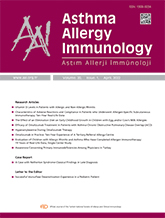


Objective: Omalizumab safety studies have shown that the drug has an excellent safety profile and is well tolerated in patients with asthma and chronic idiopatic urticaria (CIU) with no blood chemistry monitoring during treatment. Although our clinical experience with drug has pointed out abnormalities in amylase levels. The aim of the present study is to assess blood amylase values during omalizumab therapy and to explain if there is an association between omalizumab therapy and high serum amylase levels.
Materials and Methods: Patients who received omalizumab therapy for severe persistent allergic asthma or CIU between November 2015 and December 2016 were included in the study. Complete blood counts and biochemistry including liver function tests, amylase, pancreatic amylase, and lipase blood levels were evaluated at basal and every visit before omalizumab administration. Patients were evaluated at the time of injection visits that were scheduled every 2 to 4 weeks based on omalizumab dosage. Laboratory assessments followed up at least 1 month to one year. Patients that developed persistent hyperamylasemia carried on with further diagnostic work-up.
Results: Of the total 76 patients, 59 (77.6%) had a diagnosis of CIU and 17 (22.4%) had severe persistent allergic asthma. The median cumulative dose of omalizumab was 4350 (range 900-36000) mg. In the follow-up period, at least one high amylase level was observed in 17 (22.4%) patients. Of these, 11 patients had transient amylase elevation, which returned to the normal range during follow-up. The remaining 6 patients had persistent amylase elevation and underwent further diagnostic examinations. Macroamylasemia was considered as a differential diagnosis and one patient had laboratory tests for macroamylasemia but the results were found within normal limits. There was no statistically significant difference between patients with transient and persistent amylase elevation compared with patients with normal amylase levels in terms of disease, duration of disease, duration of treatment, omalizumab cumulative dose, age, body mass index, and alcohol consumption.
Conclusion: Hyperamylasemia associated with omalizumab therapy is not clear, on the other hand it is a diagnosis of exclusion and all other probable causes of hyperamylasemia were sufficiently excluded. Physicians should be aware of elevated amylase levels in patients treated with omalizumab. To preclude confusion on hyperamylasemia in patients who receive omalizumab, we recommend assessing baseline levels of amylase to clarify if omalizumab causes hyperamylasemia in the treatment period.